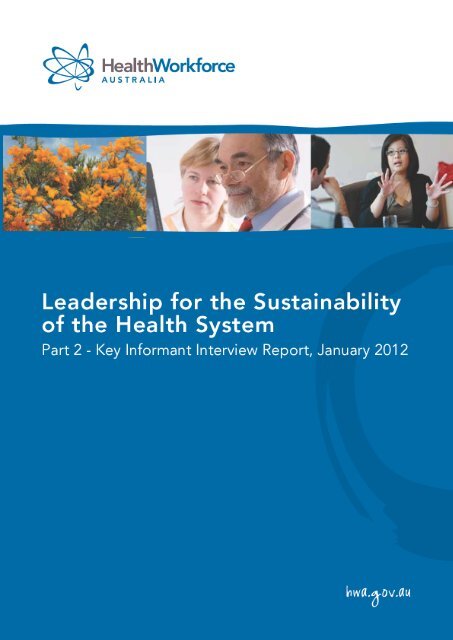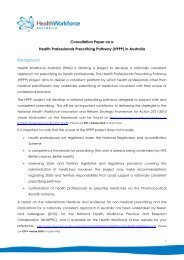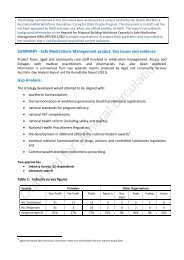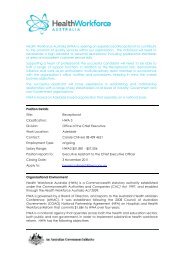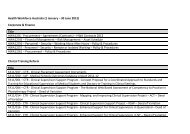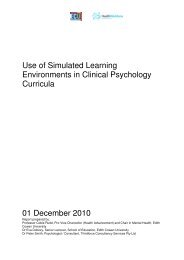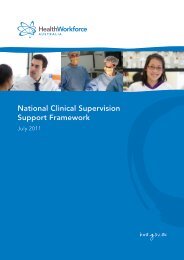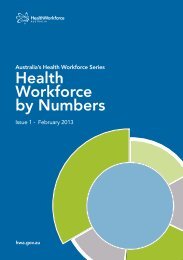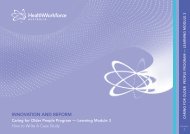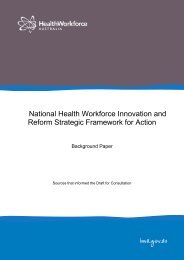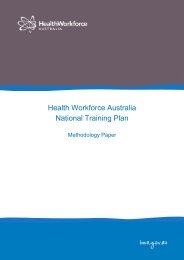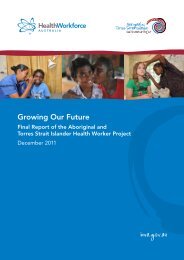Leadership for the Sustainability of the Health System: Part 2 - Key ...
Leadership for the Sustainability of the Health System: Part 2 - Key ...
Leadership for the Sustainability of the Health System: Part 2 - Key ...
Create successful ePaper yourself
Turn your PDF publications into a flip-book with our unique Google optimized e-Paper software.
ForewordI am pleased to present this three-part report on <strong>Leadership</strong> <strong>for</strong> <strong>the</strong> <strong>Sustainability</strong> <strong>of</strong> <strong>the</strong> <strong>Health</strong><strong>System</strong>. It addresses <strong>the</strong> challenges involved in improving and sustaining an effective health systemto meet <strong>the</strong> needs <strong>of</strong> <strong>the</strong> Australian community and makes recommendations <strong>for</strong> future activity.<strong>Health</strong> Work<strong>for</strong>ce Australia (HWA) is an initiative <strong>of</strong> <strong>the</strong> Council <strong>of</strong> Australian Governments and hasbeen created as a cross-jurisdictional body operating in <strong>the</strong> government and non-governmen<strong>the</strong>alth sectors, as well as <strong>the</strong> higher education sector, to address Australia’s critical healthwork<strong>for</strong>ce planning, training and re<strong>for</strong>m challenges.In August 2011 <strong>the</strong> Ministers approved <strong>the</strong> National <strong>Health</strong> Work<strong>for</strong>ce Innovation and Re<strong>for</strong>mStrategic Framework <strong>for</strong> Action 2011–2015 1 . This policy framework will guide <strong>the</strong> innovations andre<strong>for</strong>ms necessary to deliver a sustainable health work<strong>for</strong>ce into <strong>the</strong> future. <strong>Leadership</strong> <strong>for</strong> <strong>the</strong><strong>Sustainability</strong> <strong>of</strong> <strong>the</strong> <strong>Health</strong> <strong>System</strong> is a key domain <strong>for</strong> action.At <strong>the</strong> national level <strong>the</strong>re are major re<strong>for</strong>ms <strong>for</strong>eshadowed or underway, and strong leadershipcapacity will be required to guide <strong>the</strong> work<strong>for</strong>ce changes required to support national re<strong>for</strong>ms.Effective leadership will build and support capacity <strong>for</strong> innovation and change.In order to ensure evidence-based approaches to its work in <strong>the</strong> leadership domain, HWAcommissioned a study to guide consideration <strong>of</strong> <strong>the</strong> priority steps. The report provides a thoughtfulanalysis <strong>of</strong> some <strong>the</strong> challenges faced by health leaders nationally and internationally.Recommendations include:improving <strong>the</strong> content, delivery and evaluation <strong>of</strong> current leadership development <strong>of</strong>feringsemphasising leadership at all organisational levels and in every area <strong>of</strong> health caresupporting <strong>the</strong> integration <strong>of</strong> both clinical and corporate leadership developmenttrans<strong>for</strong>ming organisational cultures to foster innovation, creativity and changethinking in system terms and engaging with o<strong>the</strong>rs across sectors and jurisdictionsengaging with consumers, patients and communities as a critical part <strong>of</strong> systemimprovement.The report also highlights <strong>the</strong> need to increase <strong>the</strong> number <strong>of</strong> leadership developmentopportunities available to Aboriginal and Torres Strait Islander people in <strong>the</strong> health work<strong>for</strong>ce. HWAis collaborating with Aboriginal and Torres Strait Islander organisations and key leaders to determinean appropriate course <strong>of</strong> action.1<strong>Health</strong> Work<strong>for</strong>ce Australia (2011). National <strong>Health</strong> Work<strong>for</strong>ce Innovation and Re<strong>for</strong>m Strategic Framework <strong>for</strong> Action 2011-2015 Adelaide www.hwa.gov.au<strong>Leadership</strong> <strong>for</strong> <strong>the</strong> <strong>Sustainability</strong> <strong>of</strong> <strong>the</strong> <strong>Health</strong> <strong>System</strong>: <strong>Part</strong> 2 – <strong>Key</strong> In<strong>for</strong>mant Interview ReportPage i
This is in line with a commitment in <strong>the</strong> National <strong>Health</strong> Work<strong>for</strong>ce Innovation and Re<strong>for</strong>m StrategicFramework <strong>for</strong> Action 2011–2015 to ‘Accelerate progress in achieving <strong>the</strong> goals <strong>of</strong> Closing <strong>the</strong> Gapby building and supporting <strong>the</strong> leadership capacity <strong>of</strong> <strong>the</strong> Aboriginal and Torres Strait Islanderhealth work<strong>for</strong>ce’ 2 .The report makes a worthwhile contribution to <strong>the</strong> leadership discussion with particular resonance<strong>for</strong> those interested in health. I commend it to leaders and to those working in <strong>the</strong> areas <strong>of</strong> healthwork<strong>for</strong>ce development and leadership education.Mark CormackChief Executive Officer, HWA2<strong>Health</strong> Work<strong>for</strong>ce Australia (2011). National <strong>Health</strong> Work<strong>for</strong>ce Innovation and Re<strong>for</strong>m Strategic Framework <strong>for</strong> Action 2011-2015 Adelaide www.hwa.gov.au<strong>Leadership</strong> <strong>for</strong> <strong>the</strong> <strong>Sustainability</strong> <strong>of</strong> <strong>the</strong> <strong>Health</strong> <strong>System</strong>: <strong>Part</strong> 2 – <strong>Key</strong> In<strong>for</strong>mant Interview ReportPage ii
ContentsContents .................................................................................................................................................................. iiiExecutive summary ................................................................................................................................................ 1Major challenges facing health leaders ....................................................................................................... 1Suggested improvements to leadership programs ..................................................................................... 2Introduction ............................................................................................................................................................. 5Background ......................................................................................................................................................... 5The case <strong>for</strong> change and <strong>the</strong> place <strong>of</strong> leadership ..................................................................................... 6About <strong>Health</strong> Work<strong>for</strong>ce Australia .................................................................................................................. 7<strong>Key</strong> in<strong>for</strong>mant interview report ............................................................................................................................ 9Methodology ...................................................................................................................................................... 9Results ................................................................................................................................................................. 11Major challenges facing leaders in <strong>the</strong> health sector .......................................................................... 11<strong>Leadership</strong> development ........................................................................................................................... 15HWA’s potential role .................................................................................................................................... 23<strong>Leadership</strong> <strong>for</strong> <strong>the</strong> <strong>Sustainability</strong> <strong>of</strong> <strong>the</strong> <strong>Health</strong> <strong>System</strong>: <strong>Part</strong> 2 – <strong>Key</strong> In<strong>for</strong>mant Interview ReportPage iii
Executive summaryOne <strong>of</strong> <strong>the</strong> five domains <strong>of</strong> <strong>the</strong> National <strong>Health</strong> Work<strong>for</strong>ce Innovation and Re<strong>for</strong>m StrategicFramework <strong>for</strong> Action 2011–2015 3 concerns leadership <strong>for</strong> <strong>the</strong> sustainability <strong>of</strong> <strong>the</strong> health caresystem. Work to ensure that health care systems can be sustained is an urgent priority <strong>for</strong>governments globally. <strong>Leadership</strong> capacity is essential to success in introducing <strong>the</strong> innovation andchange that will sustain <strong>the</strong> health care system. <strong>Health</strong> Work<strong>for</strong>ce Australia (HWA) commissioned areport to in<strong>for</strong>m <strong>the</strong> next steps to develop that capacity.The report comprised:an environmental scan <strong>of</strong> national and international activity in leadership as it applies toimplementing innovation and changea literature review <strong>of</strong> <strong>the</strong> <strong>the</strong>ories, research and evidence on leadership, leadershipdevelopment, and o<strong>the</strong>r organisational and system enablers that affect <strong>the</strong> return oninvestment <strong>of</strong> leadership developmenta summary <strong>of</strong> <strong>the</strong> findings <strong>of</strong> in<strong>for</strong>mant interviews on <strong>the</strong> current status and future direction <strong>of</strong>leadership developmentan analysis <strong>of</strong> <strong>the</strong> material captured in <strong>the</strong> environmental scan, in<strong>for</strong>med by <strong>the</strong> conclusionsand recommendations <strong>of</strong> <strong>the</strong> literature review and interviewsa syn<strong>the</strong>sis <strong>of</strong> <strong>the</strong> key findings and recommendations from <strong>the</strong> literature review, interviewsand environmental scan to provide advice and recommendations <strong>for</strong> HWA on how to bestbuild on and support existing ef<strong>for</strong>ts in leadership development in Australia.This paper presents <strong>the</strong> findings and recommendations <strong>of</strong> a review <strong>of</strong> <strong>the</strong> literature on effectiveleadership and its development in health systems.Major challenges facing health leadersThe central challenges facing health leaders, identified by key in<strong>for</strong>mants, were how best to:address <strong>the</strong> interrelated challenges <strong>of</strong> changing demography, epidemiology and work<strong>for</strong>ceprovide leadership that focuses services and providers on consumer and community needlead leaders and autonomous health pr<strong>of</strong>essionalsmaximise productivity to meet increasing and changing demanddisseminate innovation and effect changereduce scepticism, change weariness, and change wariness and work with persistence andcouragebring about culture changenavigate <strong>the</strong> political nature <strong>of</strong> health.3<strong>Health</strong> Work<strong>for</strong>ce Australia (2011). National <strong>Health</strong> Work<strong>for</strong>ce Innovation and Re<strong>for</strong>m Strategic Framework <strong>for</strong> Action 2011-2015 Adelaide www.hwa.gov.au<strong>Leadership</strong> <strong>for</strong> <strong>the</strong> <strong>Sustainability</strong> <strong>of</strong> <strong>the</strong> <strong>Health</strong> <strong>System</strong>: <strong>Part</strong> 2 – <strong>Key</strong> In<strong>for</strong>mant Interview Report Page 1
Suggested improvements to leadership programsIn reflecting on <strong>the</strong> adequacy <strong>of</strong> <strong>the</strong> leadership development opportunities <strong>of</strong> which key in<strong>for</strong>mantswere aware, <strong>the</strong>y made several suggestions to increase return on investment.Content<strong>Key</strong> in<strong>for</strong>mants recommended <strong>the</strong> following improvements to leadership development programs:incorporate training in building measurement and evaluation into change programsprovide education on how to trans<strong>for</strong>m an organisation’s culture to foster innovation,creativity and changedevelop health leaders’ ability to think in systems terms and effect change in complexadaptive systemsprovide support <strong>for</strong> health leaders from clinical backgrounds to develop <strong>the</strong> level <strong>of</strong> businessacumen necessary to meet <strong>the</strong> broad fiduciary responsibilities (financial, clinical andpopulation outcomes) <strong>of</strong> leadership positions in health care systemssupport <strong>the</strong> development <strong>of</strong> personal and interpersonal skills necessary to hold o<strong>the</strong>rs toaccount and promote <strong>the</strong> ethical use <strong>of</strong> influence, avoid conflicts <strong>of</strong> interest, and meet <strong>the</strong>implicit contract <strong>of</strong> trust between <strong>the</strong> health system and <strong>the</strong> communitybuild understanding that consumer feedback and in<strong>for</strong>mation is an essential source <strong>of</strong> <strong>the</strong>intelligence necessary to in<strong>for</strong>m <strong>the</strong> kinds <strong>of</strong> innovation, improvement and redesign <strong>of</strong> healthsystems that will reflect <strong>the</strong> patient experience, and support population health outcomesincorporate training in building political support within organisations “small ‘p’” and acrosspolitical parties “big ‘P’” to manage <strong>the</strong> overall politics in health.centre <strong>the</strong> focus <strong>of</strong> leadership development on emotional awareness/intelligence, <strong>the</strong>capacity to build trust and relationships, leading by influence instead <strong>of</strong> positional authority,engaging with staff and communicating a shared vision, and using intrinsic motivation toinspire staff in <strong>the</strong> direction <strong>of</strong> a desired goal.Delivery<strong>Key</strong> in<strong>for</strong>mants suggested <strong>the</strong> delivery <strong>of</strong> leadership programs could be improved by:involving senior managers in <strong>the</strong> presentation and delivery <strong>of</strong> leadership programs toincrease engagement and share ‘real world’ experienceembedding leadership development in quality improvement, safety or lean health caretraining, as this would go some way towards rectifying <strong>the</strong> misconception that clinicalleadership is about placing clinicians in <strong>for</strong>mal leadership positions and would promoteleadership development as something that has <strong>the</strong> potential to support improvements inservice deliveryproviding ongoing support <strong>for</strong> health leaders, including establishing ‘communities <strong>of</strong> support’<strong>Leadership</strong> <strong>for</strong> <strong>the</strong> <strong>Sustainability</strong> <strong>of</strong> <strong>the</strong> <strong>Health</strong> <strong>System</strong>: <strong>Part</strong> 2 – <strong>Key</strong> In<strong>for</strong>mant Interview Report Page 2
uilding connections across boundaries by including people from across pr<strong>of</strong>essional silos,jurisdictions and <strong>the</strong> government, non-government and private sectors in health, and eveno<strong>the</strong>r industries<strong>of</strong>fering mentoring opportunitiesensuring wherever possible that training and development is conducted interpr<strong>of</strong>essionallyembedding leadership development in undergraduate and postgraduate trainingdeveloping <strong>the</strong> most senior health leaders in <strong>the</strong> system as a group using strong relationalmodelsincluding leaders from <strong>the</strong> Australian Department <strong>of</strong> <strong>Health</strong> and Ageing in leadershipdevelopment opportunities and activities with senior state and territory staff.Coverage<strong>Key</strong> in<strong>for</strong>mants suggested <strong>the</strong> coverage <strong>of</strong> leadership development programs could be improvedby:<strong>of</strong>fering leadership development opportunities to all administrative and clinical healthpr<strong>of</strong>essionalsdeveloping <strong>the</strong> capacity to identify emerging leaders and select <strong>the</strong>m <strong>for</strong> leadershipdevelopment and <strong>for</strong>mal leadership positions<strong>of</strong>fering incentives to participate in leadership development opportunities, such asarticulation <strong>of</strong> leadership courses with postgraduate diplomas or o<strong>the</strong>r qualifications<strong>of</strong>fering senior leaders ongoing development, as a large percentage <strong>of</strong> this cohort has notreceived <strong>for</strong>mal development in a number <strong>of</strong> decades.HWA’s potential role<strong>Key</strong> in<strong>for</strong>mants made suggestions about possible roles HWA could play in facilitating <strong>the</strong>development <strong>of</strong> health system leaders. These included:developing <strong>the</strong> most senior leaders <strong>of</strong> <strong>the</strong> health system by:establishing cross-jurisdictional leadership development opportunities <strong>for</strong> <strong>the</strong>seindividuals to provide <strong>the</strong>m with a community <strong>of</strong> support and a source <strong>of</strong> guidanceexposing <strong>the</strong>m to best practice internationallybringing <strong>the</strong>m toge<strong>the</strong>r with health educators, course accreditors and regulators todiscuss <strong>the</strong> development <strong>of</strong> future health system leaderstraining <strong>the</strong>m in managing small ‘p’ and big ‘P’ politics in health carebuilding and maintaining a national pool <strong>of</strong> evidence on what works in leadershipdevelopment and what is available both nationally and internationallydeveloping a national evaluation strategy that could assess <strong>the</strong> return on investment <strong>of</strong>leadership development programs run nationally and by <strong>the</strong> jurisdictions<strong>Leadership</strong> <strong>for</strong> <strong>the</strong> <strong>Sustainability</strong> <strong>of</strong> <strong>the</strong> <strong>Health</strong> <strong>System</strong>: <strong>Part</strong> 2 – <strong>Key</strong> In<strong>for</strong>mant Interview Report Page 3
developing a national leadership competency framework to ensure a common languageand understanding is shared by all <strong>the</strong> jurisdictionsworking to ensure <strong>the</strong> national competency framework is embedded into healthorganisations by <strong>the</strong> jurisdictionsplaying a role in <strong>the</strong> development <strong>of</strong> Aboriginal and Torres Strait Islander health leadersworking with key pr<strong>of</strong>essional associations and health organisations to build a betterunderstanding in <strong>the</strong> health system and in <strong>the</strong> community <strong>of</strong> <strong>the</strong> contribution <strong>of</strong> sound policy,management and leadershipworking with jurisdictions and o<strong>the</strong>r stakeholders, such as <strong>the</strong> Australian College <strong>of</strong> <strong>Health</strong>Service Management, to build governance and leadership support <strong>for</strong> emergingorganisational <strong>for</strong>ms (Medicare Locals and Local <strong>Health</strong> and Hospital Networks) undernational health re<strong>for</strong>m.<strong>Leadership</strong> <strong>for</strong> <strong>the</strong> <strong>Sustainability</strong> <strong>of</strong> <strong>the</strong> <strong>Health</strong> <strong>System</strong>: <strong>Part</strong> 2 – <strong>Key</strong> In<strong>for</strong>mant Interview Report Page 4
The case <strong>for</strong> change and <strong>the</strong> place <strong>of</strong> leadershipIn December 2005 <strong>the</strong> Productivity Commission identified <strong>the</strong> demand and supply issues in healththat Australia must confront in <strong>the</strong> next decade. These issues included:a changed mixture <strong>of</strong> disease burdens, including increasing numbers <strong>of</strong> people who will besuffering type 2 diabetes and dementiaincreased individual spending on health care, and increased expectations <strong>of</strong> timely accessto high-quality health services<strong>the</strong> need <strong>for</strong> different models <strong>of</strong> care and new work<strong>for</strong>ce practices to accommodate andutilise <strong>the</strong> wider range <strong>of</strong> treatment possibilities arising from new technologiesan ageing and longer-living population that will significantly increase health expenditure and<strong>the</strong> incidence <strong>of</strong> chronic disease<strong>the</strong> increasing average age <strong>of</strong> health workers and <strong>the</strong> need to replace greater numbers <strong>of</strong>retiring workers, in a context where health work<strong>for</strong>ce supply already fails to keep up withdemand.In all OECD (Organisation <strong>for</strong> Economic Co-operation and Development) countries, total spendingon health care is rising faster than economic growth, and it has been predicted that <strong>the</strong> cost <strong>of</strong>health care could reach 20% <strong>of</strong> gross domestic product by 2020 owing to <strong>the</strong> increasing affluenceand longevity <strong>of</strong> populations in developed countries. 6 Australia’s changing age pr<strong>of</strong>ile willsignificantly increase health spending. Spending on <strong>the</strong> over 65s may be as much as four timesmore per person than on those under 65. 7In light <strong>of</strong> <strong>the</strong> global nature <strong>of</strong> health and health work<strong>for</strong>ce challenges, and <strong>the</strong> results <strong>of</strong> researchand evidence both at home and overseas, <strong>the</strong> momentum towards health service redesign mustincrease, and <strong>the</strong> work<strong>for</strong>ce re<strong>for</strong>m and innovation necessary to support it must also increase. Thepace, level and nature <strong>of</strong> <strong>the</strong> needed change and innovation demand significantly increasedleadership at all levels <strong>of</strong> <strong>the</strong> system.The current focus is on:increasing numbers in <strong>the</strong> work<strong>for</strong>ce—increasing numbers <strong>of</strong> clinical training places,encouraging re-entry, supporting retentionredesigning to support increased productivity—organisational and service redesign toincrease engagement in direct patient care by health pr<strong>of</strong>essionalsrole redesign—ef<strong>for</strong>ts to ensure all pr<strong>of</strong>essions work to full capacity and maximise return oninvestment in specialist training, and creation <strong>of</strong> assistant roles to free higher-skilled parts <strong>of</strong><strong>the</strong> work<strong>for</strong>ce arising from activities that only require a lower level <strong>of</strong> skill6Fogel RW (2004). The Escape from Hunger and Premature Death, 1700–2100: Europe, America, and <strong>the</strong> Third World.Cambridge Univ Press, Cambridge UK.7Productivity Commission (2005). Australia’s health work<strong>for</strong>ce. Productivity Commission Research Report, Canberra,Australia.<strong>Leadership</strong> <strong>for</strong> <strong>the</strong> <strong>Sustainability</strong> <strong>of</strong> <strong>the</strong> <strong>Health</strong> <strong>System</strong>: <strong>Part</strong> 2 – <strong>Key</strong> In<strong>for</strong>mant Interview Report Page 6
quality and safety ef<strong>for</strong>ts to reduce adverse outcomes and avoidable admissions andattendances at health services.While <strong>the</strong>se are important aims, <strong>the</strong> evidence strongly suggests that <strong>the</strong>y will be inadequate toaddress threats to <strong>the</strong> sustainability <strong>of</strong> <strong>the</strong> health system, <strong>the</strong> appropriateness <strong>of</strong> models <strong>of</strong> servicedelivery, and <strong>the</strong> structure and availability <strong>of</strong> <strong>the</strong> health work<strong>for</strong>ce. The extent and nature <strong>of</strong>population needs are changing rapidly and require a different order <strong>of</strong> change at national,regional and global levels.What is considered possible is constrained by thinking that continues to focus on working <strong>for</strong>wardfrom <strong>the</strong> existing pr<strong>of</strong>essions and <strong>the</strong>ir interests, skill demarcations and responsibilities. What isrequired is leadership capable <strong>of</strong> promoting a paradigm shift in ways <strong>of</strong> thinking about healthsystem and work<strong>for</strong>ce design and planning—ways that work backwards from outcomes <strong>for</strong>consumers and communities and population need.<strong>Leadership</strong> development to achieve this paradigm shift demands new ways <strong>of</strong> thinking. The systemneeds increased capacity in its leaders to design health systems that follow <strong>the</strong> patient journey,engage patients and communities in <strong>the</strong> change process, and promote and support wellness as wellas treat disease.About <strong>Health</strong> Work<strong>for</strong>ce AustraliaHWA is an initiative <strong>of</strong> <strong>the</strong> Council <strong>of</strong> Australian Governments and has been established to address<strong>the</strong> challenges <strong>of</strong> proving a skilled, flexible and innovative health work<strong>for</strong>ce that meets <strong>the</strong> needs<strong>of</strong> <strong>the</strong> Australian community, now and into <strong>the</strong> future.HWA was established following <strong>the</strong> development <strong>of</strong> a $1.6 billion National <strong>Part</strong>nership Agreementon Hospital and <strong>Health</strong> Work<strong>for</strong>ce Re<strong>for</strong>m, by <strong>the</strong> Commonwealth and State and TerritoryGovernments in November 2008.HWA reports to <strong>Health</strong> Ministers and will operate across health and education sectors to devisesolutions that integrate work<strong>for</strong>ce planning, policy and re<strong>for</strong>m with <strong>the</strong> necessary andcomplementary re<strong>for</strong>ms to education and training.HWA’s functions include:<strong>the</strong> provision <strong>of</strong> comprehensive, authoritative national work<strong>for</strong>ce planning, policy andresearch advice to Ministers, governments and key decision makers in <strong>the</strong> health andeducation sectorsimproving and expanding access to quality clinical education placements <strong>for</strong> healthpr<strong>of</strong>essionals in training across <strong>the</strong> public, private and non-government sectors; this will beachieved through programs that expand capacity, improve quality and <strong>of</strong>fer diversity inlearning opportunities; this also includes a national network <strong>of</strong> simulated learningenvironments, or SLEs, to enhance <strong>the</strong> quality, safety and efficiency <strong>of</strong> clinical training<strong>Leadership</strong> <strong>for</strong> <strong>the</strong> <strong>Sustainability</strong> <strong>of</strong> <strong>the</strong> <strong>Health</strong> <strong>System</strong>: <strong>Part</strong> 2 – <strong>Key</strong> In<strong>for</strong>mant Interview Report Page 7
developing and implementing a national program <strong>of</strong> health work<strong>for</strong>ce innovation andre<strong>for</strong>m; this will encourage <strong>the</strong> development <strong>of</strong> new models <strong>of</strong> health care delivery, facilitateinterpr<strong>of</strong>essional practice, and equip health pr<strong>of</strong>essionals <strong>for</strong> current and emerging demandson <strong>the</strong> health care sectorfacilitating a nationally consistent approach to international recruitment <strong>of</strong> healthpr<strong>of</strong>essionals to Australia.<strong>Leadership</strong> <strong>for</strong> <strong>the</strong> <strong>Sustainability</strong> <strong>of</strong> <strong>the</strong> <strong>Health</strong> <strong>System</strong>: <strong>Part</strong> 2 – <strong>Key</strong> In<strong>for</strong>mant Interview Report Page 8
<strong>Key</strong> in<strong>for</strong>mant interview reportMethodology<strong>Part</strong>icipantsBased on <strong>the</strong> environmental scan and after consultation with <strong>the</strong> jurisdictions, a sample <strong>of</strong>43 recognised health service leaders, expert commentators on <strong>the</strong> health system and experts inleadership development in o<strong>the</strong>r sectors were approached <strong>for</strong> interview. They represented all <strong>the</strong>states and territories <strong>of</strong> Australia, and also <strong>the</strong> United Kingdom and Canada. They comprised 27people from <strong>the</strong> health sector, and 16 from <strong>the</strong> corporate or non-government sectors. Of <strong>the</strong> 43people invited to participate, 18 did not reply to <strong>the</strong> invitation, six declined, 19 accepted and 16were available to be interviewed in <strong>the</strong> available time period (a response rate <strong>of</strong> 37%).The majority <strong>of</strong> <strong>the</strong> nominated leaders from outside <strong>the</strong> health sector were ei<strong>the</strong>r unavailable or didnot respond to <strong>the</strong> invitation. As a result, all <strong>the</strong> respondents had some <strong>for</strong>mal or in<strong>for</strong>malconnection to <strong>the</strong> health industry. Never<strong>the</strong>less, several <strong>of</strong> those interviewed had a breadth <strong>of</strong>leadership experience in industries outside health care, such as finance, in<strong>for</strong>mation technologyand construction, as well as non-health-related government departments and non-governmentorganisations. The 16 people interviewed came from three groups:four senior and executive managers <strong>of</strong> state or territory health departments, service deliveryorganisations and pr<strong>of</strong>essional associationseight directors <strong>of</strong> human resource management or organisational development <strong>of</strong> healthorganisations and institutesfour health industry commentators, academics and senior educators.DesignIn a semi-structured interview, <strong>the</strong> interviewer outlined five broad headings, and <strong>the</strong>n usedin<strong>for</strong>mation from <strong>the</strong> literature review and <strong>the</strong> environmental scan to prompt discussion, clarifyaspects <strong>of</strong> <strong>the</strong> environmental scan <strong>the</strong> interviewee had direct knowledge <strong>of</strong>, and seek moredetailed reflection. The five areas <strong>for</strong> discussion were:what are <strong>the</strong> major challenges facing leaders in <strong>the</strong> health sector?what leadership development opportunities are <strong>the</strong>y aware <strong>of</strong>?what is <strong>the</strong> adequacy <strong>of</strong> current leadership development ef<strong>for</strong>ts?what else might be done to develop leadership or increase return on investment in currentleadership development ef<strong>for</strong>ts?what could HWA do to add value to leadership development ef<strong>for</strong>ts?The questions posed were tailored to <strong>the</strong> interviewees on <strong>the</strong> basis <strong>of</strong> <strong>the</strong>ir capacity to answer (<strong>for</strong>example, people not employed in <strong>the</strong> health system were not asked about leadershipdevelopment opportunities in <strong>the</strong> system). The interviews were conducted from early June to early<strong>Leadership</strong> <strong>for</strong> <strong>the</strong> <strong>Sustainability</strong> <strong>of</strong> <strong>the</strong> <strong>Health</strong> <strong>System</strong>: <strong>Part</strong> 2 – <strong>Key</strong> In<strong>for</strong>mant Interview Report Page 9
July 2011 and <strong>the</strong> results were subjected to a ‘framework analysis’ approach following Krueger’s 8 , 9method, which draws heavily on <strong>the</strong> framework analysis procedure first described by Ritchie andSpencer. 10Framework analysis can be thought <strong>of</strong> as a continuum <strong>of</strong> analysis ranging from <strong>the</strong> mereaccumulation <strong>of</strong> raw data to <strong>the</strong> interpretation <strong>of</strong> data, although it is not a linear process, andeach step overlaps <strong>the</strong> next, as shown below:The five key stages outlined by Krueger are familiarisation; identifying a <strong>the</strong>matic framework;indexing; charting; and mapping and interpretation. The o<strong>the</strong>r distinctive aspect <strong>of</strong> frameworkanalysis is that, although it uses a <strong>the</strong>matic approach, it allows <strong>the</strong>mes to develop both from <strong>the</strong>research questions and from <strong>the</strong> narratives <strong>of</strong> participants. Qualitative research generates largeamounts <strong>of</strong> data, and it is important that <strong>the</strong> purpose <strong>of</strong> <strong>the</strong> study drives <strong>the</strong> analysis. At <strong>the</strong> sametime, it is important to capture emerging <strong>the</strong>mes from interviews that will fur<strong>the</strong>r in<strong>for</strong>m <strong>the</strong> project.Because <strong>of</strong> <strong>the</strong> volume <strong>of</strong> data generated from qualitative research, it is important to ensurereliability <strong>of</strong> <strong>the</strong> coding <strong>of</strong> data, since more than one researcher is likely to be independentlycoding <strong>the</strong> data. Codes are words or devices <strong>for</strong> identifying <strong>the</strong>mes. The process developed byHruschka et al. 11 maximises inter-coder reliability in coding open-ended data. The process involvessegmenting <strong>the</strong> data, developing a draft codebook, testing <strong>the</strong> reliability <strong>of</strong> a sample <strong>of</strong> data by atleast two independent coders, checking and modification <strong>of</strong> <strong>the</strong> codebook be<strong>for</strong>e final coding,and finally quality control <strong>of</strong> all data by <strong>the</strong> lead coder.The framework analysis and inter-rater reliability testing builds a database <strong>of</strong> coded qualitativedata that can be sorted into various <strong>the</strong>mes and is traceable <strong>for</strong> verification and checking <strong>of</strong> <strong>the</strong>final analysis and interpretation that will <strong>for</strong>m part <strong>of</strong> <strong>the</strong> report. The differences and commonalitiesin <strong>the</strong> <strong>the</strong>mes identified by <strong>the</strong> coders are discussed and resolved to produce a summary <strong>of</strong> <strong>the</strong>implications <strong>of</strong> <strong>the</strong> in<strong>for</strong>mants’ views.The findings documented in <strong>the</strong> following sections <strong>of</strong> this report are <strong>the</strong> result <strong>of</strong> a <strong>the</strong>matic analysis<strong>of</strong> <strong>the</strong> views <strong>of</strong> <strong>the</strong> respondents, not <strong>of</strong> <strong>the</strong> consultants.8Krueger RA (1994). Focus Groups: A Practical Guide <strong>for</strong> Applied Research. Thousand Oaks, CA: Sage Publications.9Krueger RA & Casey MA (2000). Focus Groups: A Practical Guide <strong>for</strong> Applied Research (3rd ed.). Thousand Oaks, CA: SagePublications.10Ritchie J & Spencer L (1994). Qualitative data analysis <strong>for</strong> applied policy research. In A Bryman & RG Burgess (eds),Analysing Qualitative Research. London: Routledge: 173–94.11Hruschka DJ, Schwartz D, Cobb St John D, Picone-Decaro E, Jenkins RA & Carey JW (2004). Reliability in coding openendeddata: lessons learned from HIV behavioral research. Field Methods 16(3): 307–31.<strong>Leadership</strong> <strong>for</strong> <strong>the</strong> <strong>Sustainability</strong> <strong>of</strong> <strong>the</strong> <strong>Health</strong> <strong>System</strong>: <strong>Part</strong> 2 – <strong>Key</strong> In<strong>for</strong>mant Interview Report Page 10
These findings have been syn<strong>the</strong>sised with <strong>the</strong> findings from <strong>the</strong> literature review and environmentalscan to provide advice about options <strong>for</strong> HWA to consider <strong>for</strong> its role in <strong>the</strong> leadership space.ResultsMajor challenges facing leaders in <strong>the</strong> health sectorIn general, respondents who had recent experience in line management <strong>of</strong> health services said <strong>the</strong>biggest challenge was developing individuals capable <strong>of</strong> leading <strong>the</strong> health system throughrapidly changing epidemiology and demography.Those in human resources or organisational development positions spoke most about buildingbusiness acumen and developing <strong>the</strong> skills required <strong>for</strong> change management and culture change.<strong>Health</strong> industry commentators and academics focused more on developing leaders capable <strong>of</strong>navigating <strong>the</strong> party politics surrounding health, and <strong>the</strong> small ‘p’ politics <strong>of</strong> vested interests andpr<strong>of</strong>essional groups involved in <strong>the</strong> delivery <strong>of</strong> health services.Service leaders and health industry commentators, educators and academics stressed <strong>the</strong>absence <strong>of</strong> an au<strong>the</strong>ntic consumer focus as a major challenge <strong>for</strong> health leaders.The major high-level <strong>the</strong>mes that emerged from analysis <strong>of</strong> interview transcripts were:addressing <strong>the</strong> interrelated challenges <strong>of</strong> changing demography, epidemiology andwork<strong>for</strong>ceproviding leadership that focuses services and providers on consumer and community need<strong>the</strong> distinctive nature <strong>of</strong> <strong>the</strong> health work<strong>for</strong>ce—leading leaders and autonomous healthpr<strong>of</strong>essionalsmaximising productivity to meet increasing and changing demandleadership <strong>for</strong> <strong>the</strong> dissemination <strong>of</strong> innovation and change managementreducing scepticism, change weariness and change wariness, and <strong>the</strong> need <strong>for</strong> persistenceand courageculture changenavigating <strong>the</strong> political nature <strong>of</strong> health.vested interests and <strong>the</strong> ethical expression <strong>of</strong> influence and powerThese major <strong>the</strong>mes will be illustrated in turn.Addressing <strong>the</strong> interrelated challenges <strong>of</strong> changing demography, epidemiologyand work<strong>for</strong>ceThe imminent impact <strong>of</strong> <strong>the</strong> ageing <strong>of</strong> <strong>the</strong> population, <strong>the</strong> dramatic increase in chronic illness andwork<strong>for</strong>ce maldistribution present challenges to health service leaders and systems that are <strong>of</strong> ascale not experienced by most in <strong>the</strong>ir careers to date.<strong>Leadership</strong> <strong>for</strong> <strong>the</strong> <strong>Sustainability</strong> <strong>of</strong> <strong>the</strong> <strong>Health</strong> <strong>System</strong>: <strong>Part</strong> 2 – <strong>Key</strong> In<strong>for</strong>mant Interview Report Page 11
The solutions <strong>of</strong> <strong>the</strong> past, <strong>the</strong> demarcations among and between <strong>the</strong> pr<strong>of</strong>essions, and <strong>the</strong> way <strong>the</strong>iraccountabilities have been defined (facility and pr<strong>of</strong>ession based) are proving inadequate.In this context <strong>the</strong> priority <strong>of</strong> leadership and leadership development tasks involve focusing on <strong>the</strong>system from <strong>the</strong> patient journey perspective across <strong>the</strong> full continuum <strong>of</strong> care and dramaticallyincreasing <strong>the</strong> level <strong>of</strong> consumer engagement in policy, planning, facility and patientmanagement.Providing leadership that focuses services and providers on consumer andcommunity needDespite recent national and international ef<strong>for</strong>t, <strong>the</strong> deep culture <strong>of</strong> health services (and <strong>the</strong>pr<strong>of</strong>essions that work in <strong>the</strong>m) remains facility, disease and pr<strong>of</strong>ession focused. The financial andnon-financial incentives in <strong>the</strong> system, while changing, still mainly support traditional role andpractice demarcations. These traditional demarcations no longer always match <strong>the</strong> pattern andlevel <strong>of</strong> need or <strong>the</strong> reality that <strong>the</strong> bulk <strong>of</strong> <strong>the</strong> management <strong>of</strong> chronic illness and aged carehappens away from service providers and, in fact, is ‘self-management’ facilitated or supported by<strong>the</strong> health system. Unlike o<strong>the</strong>r innovative and successful industries, <strong>the</strong> use <strong>of</strong> ‘customer’ orconsumer views in <strong>the</strong> design <strong>of</strong> individual care plans, health services, facilities and systems is verylow. <strong>Health</strong> leaders <strong>the</strong>mselves are most <strong>of</strong>ten a product <strong>of</strong> <strong>the</strong> <strong>for</strong>mal and in<strong>for</strong>mal education thathas permitted this lack <strong>of</strong> deep interest in <strong>the</strong> consumer experience <strong>of</strong> health, ill health and healthcare.Building appreciation <strong>of</strong>, and capacity and confidence in, consumer engagement was seen as amajor determinant <strong>of</strong> health leaders’ influence with <strong>the</strong>ir colleagues and a key to successful culturechange with health pr<strong>of</strong>essionals who are patient ra<strong>the</strong>r than corporately focused.The distinctive nature <strong>of</strong> <strong>the</strong> health work<strong>for</strong>ce: leading leaders and autonomoushealth pr<strong>of</strong>essionalsThe nature <strong>of</strong> <strong>the</strong> work in health services and <strong>the</strong> enculturation <strong>of</strong> health pr<strong>of</strong>essionals result in awork<strong>for</strong>ce most focused on individual or group clinical outcomes, research and teaching.Corporate loyalties, where <strong>the</strong>y exist, are to pr<strong>of</strong>essions and <strong>the</strong> protection <strong>of</strong> pr<strong>of</strong>essionalautonomy ra<strong>the</strong>r than to <strong>the</strong> achievement <strong>of</strong> organisational goals such as cost containment.Where organisational loyalties exist, <strong>the</strong>y are <strong>of</strong>ten to <strong>the</strong> facilities in which people train and workbut not to <strong>the</strong> broader health system and even less to health departments. Leading system-widechange that requires <strong>the</strong> sustained buy-in <strong>of</strong> autonomous health pr<strong>of</strong>essionals or healthpr<strong>of</strong>essionals intent on <strong>the</strong> preservation <strong>of</strong> <strong>the</strong>ir alma mater or <strong>the</strong>ir role takes different skills fromthose that might be successful in o<strong>the</strong>r industries. It requires <strong>the</strong> ability to lead leaders andindividuals who are <strong>of</strong>ten enormously self-confident, independent and not trained <strong>for</strong>, orcom<strong>for</strong>table in, follower roles.<strong>Leadership</strong> <strong>for</strong> <strong>the</strong> <strong>Sustainability</strong> <strong>of</strong> <strong>the</strong> <strong>Health</strong> <strong>System</strong>: <strong>Part</strong> 2 – <strong>Key</strong> In<strong>for</strong>mant Interview Report Page 12
Maximising productivity to meet increasing and changing demandThe use <strong>of</strong> <strong>the</strong> health work<strong>for</strong>ce was considered by interviewees to be inefficient, an issue that iscompounded by <strong>the</strong> increasing service delivery demands being placed on health organisations,coupled with ever-increasing budget constraints and work<strong>for</strong>ce pressures.Additionally, valid productivity data is not available to managers <strong>of</strong> health organisations, whilemanagers <strong>of</strong> o<strong>the</strong>r industries are awash in it. Inefficiencies were believed by interviewees to becaused to a large extent by a maldistribution <strong>of</strong> <strong>the</strong> health work<strong>for</strong>ce, resistance to innovation andchange in work<strong>for</strong>ce structure, and <strong>the</strong> rigidity <strong>of</strong> existing pr<strong>of</strong>essional demarcations and ‘turf wars’between some pr<strong>of</strong>essions, which prevent pr<strong>of</strong>essionals from being used to <strong>the</strong>ir full capacity.Inefficiencies were also thought to be <strong>the</strong> result <strong>of</strong> a general lack <strong>of</strong> business acumen in healthleaders.<strong>Leadership</strong> <strong>for</strong> <strong>the</strong> dissemination <strong>of</strong> innovation and change managementThe rapid increase in <strong>the</strong> availability <strong>of</strong> new treatments, in<strong>for</strong>mation and communicationapplications relevant to health, coupled with <strong>the</strong> demographic and epidemiological changesreferred to earlier, provide opportunities to address o<strong>the</strong>r challenges noted by respondents but arealso challenges in and <strong>of</strong> <strong>the</strong>mselves. Leaders need a deep understanding <strong>of</strong> how to effectivelydisseminate innovation and manage change, making maximum use <strong>of</strong> <strong>the</strong> advantages <strong>for</strong>patients, cost containment, and work<strong>for</strong>ce development and distribution.Reducing scepticism, change weariness and change wariness, and <strong>the</strong> need <strong>for</strong>persistence and courageManaging <strong>the</strong> rate and frequency <strong>of</strong> change in <strong>the</strong> health system, particularly change resultingfrom structural re<strong>for</strong>ms, coupled with <strong>the</strong> perceived failure <strong>of</strong> some past initiatives, has led to acynicism in <strong>the</strong> health work<strong>for</strong>ce about change. Additionally, <strong>the</strong> sheer pace <strong>of</strong> technological andscientific developments means that leaders and <strong>the</strong>ir colleagues face continuous change.Leading this level and type <strong>of</strong> continuous change, and encouraging and supporting <strong>the</strong> uptakeand dissemination <strong>of</strong> innovation and new evidence, corporately and clinically is a majorchallenge.Change weariness and wariness means leaders must be persistent and have courage in <strong>the</strong> face<strong>of</strong> <strong>of</strong>ten significant resistance to change. Leading through <strong>the</strong> active political and internal lobbyingby vested interest groups within and outside <strong>the</strong> health system means leaders need support and afocus on outcomes.There are concerns expressed by interviewees that because <strong>the</strong> health system has been subjectedto so many structural and financial changes, <strong>the</strong> standing <strong>of</strong> health leaders and managers hasbeen damaged. This in turn is thought to impact on <strong>the</strong> quality and number <strong>of</strong> people who arewilling to step up to leadership roles. To be sustainable, <strong>the</strong> health care system needs to be able toattract and retain <strong>the</strong> best management and leadership capacity it can.<strong>Leadership</strong> <strong>for</strong> <strong>the</strong> <strong>Sustainability</strong> <strong>of</strong> <strong>the</strong> <strong>Health</strong> <strong>System</strong>: <strong>Part</strong> 2 – <strong>Key</strong> In<strong>for</strong>mant Interview Report Page 13
While leadership development opportunities are available to provide support <strong>for</strong> those who dotake on <strong>the</strong>se roles, <strong>the</strong> perception <strong>of</strong> <strong>the</strong> sustainability <strong>of</strong> <strong>the</strong>se careers is increasingly negative.Culture changeImproving <strong>the</strong> culture <strong>of</strong> health organisations is a major challenge facing health leaders. <strong>Leadership</strong>development is <strong>the</strong> key to building <strong>the</strong> capacity <strong>for</strong> culture change.Navigating <strong>the</strong> political nature <strong>of</strong> healthBig ‘P’ politics and political astutenessBecause <strong>of</strong> <strong>the</strong> expense <strong>of</strong> health, <strong>the</strong> scarcity <strong>of</strong> resources available, <strong>the</strong> extent <strong>of</strong> conflictingviews on all health-related subjects, and <strong>the</strong> <strong>of</strong>ten competing needs and wants <strong>of</strong> stakeholders(pr<strong>of</strong>essional, consumer and community), leading health care organisations and systems will alwayshave a significant political overlay.Only one participant believed that <strong>the</strong>re was more consensus between political parties than wascommonly thought to exist and that <strong>the</strong> idea <strong>of</strong> health being used as a ‘political football’ wasoverstated.Building political support (small ‘p’ within pr<strong>of</strong>essions, and big ‘P’ across political parties) was seento be essential in bringing about <strong>the</strong> changes necessary <strong>for</strong> <strong>the</strong> sustainability <strong>of</strong> <strong>the</strong> health system.Fur<strong>the</strong>rmore, building bipartisan support was thought to be desirable as it would:encourage leaders to be braver and less risk averse and <strong>the</strong>re<strong>for</strong>e more likely to beinnovative and encourage innovation among <strong>the</strong>ir staffbuild media coverage and interest in <strong>the</strong> real issues and challenges facing <strong>the</strong> health systemversus a focus on <strong>the</strong> next ‘scandal’reduce <strong>the</strong> high turnover within upper leadership, which causes instabilityencourage talented lower-level managers to aspire to higher positions, which are currentlyperceived as being too unstable due to <strong>the</strong>ir vulnerability to <strong>the</strong> political process.The opposite side <strong>of</strong> <strong>the</strong> same coin is <strong>the</strong> need <strong>for</strong> leaders to be very politically astute, <strong>the</strong>rebybuilding political support at all levels <strong>for</strong> innovation and change. This is seen to involve:effectively and appropriately interacting with and influencing politiciansbuilding relationships with Ministers and Shadow Ministers in health and related and relevantportfolioslining up <strong>the</strong> political coalitions and anticipating how <strong>the</strong>ir opponents may react be<strong>for</strong>eimplementing any changes (see below, on intrapreneurship, <strong>for</strong> more on this)rallying after a loss so that <strong>for</strong>ward movement can be maintained.One participant contended that, among senior leaders, clinical leaders were especially in need <strong>of</strong>development in political astuteness.<strong>Leadership</strong> <strong>for</strong> <strong>the</strong> <strong>Sustainability</strong> <strong>of</strong> <strong>the</strong> <strong>Health</strong> <strong>System</strong>: <strong>Part</strong> 2 – <strong>Key</strong> In<strong>for</strong>mant Interview Report Page 14
<strong>Leadership</strong> exists at all levelsAchieving <strong>the</strong> scale <strong>of</strong> change needed in <strong>the</strong> health system will require leaders who are deeplycommitted to <strong>the</strong> mission <strong>of</strong> <strong>the</strong>ir organisation and who are prepared to navigate through itspolitics in order <strong>for</strong> <strong>the</strong> organisation to be able to achieve its mission. These leaders are known as‘intrapreneurs’; <strong>the</strong>y are employees who take personal responsibility <strong>for</strong> <strong>the</strong> change process, staybelow <strong>the</strong> radar while mobilising support <strong>for</strong> <strong>the</strong>ir ideas, and rise above <strong>the</strong> radar to facilitate <strong>the</strong>change process once sufficient support has been built to ensure <strong>the</strong>y cannot be defeated.Vested interests and <strong>the</strong> ethical expression <strong>of</strong> influence and powerVested interestsManaging <strong>the</strong> multiple and <strong>of</strong>ten conflicting expectations <strong>of</strong> vested interest groups is a majorchallenge facing leaders in and <strong>of</strong> itself. ‘Turf wars’, demarcation disputes, and <strong>the</strong> protection <strong>of</strong>pr<strong>of</strong>essional boundaries <strong>of</strong>ten enshrined in regulation, legislation and industrial awards preventleaders from structuring <strong>the</strong>ir work<strong>for</strong>ce to meet needs and increase productivity.The ethical expression <strong>of</strong> influence and power<strong>Health</strong> pr<strong>of</strong>essionals occupy a particularly privileged position in society. Their expert knowledge andskills lend credibility to <strong>the</strong>ir lobbying ef<strong>for</strong>ts. Developing leaders who exercise this influence ethicallyand in <strong>the</strong> public—ra<strong>the</strong>r than a particular pr<strong>of</strong>ession’s interest —is seen as a necessary addition to<strong>the</strong> outcomes <strong>of</strong> leadership development and a challenge <strong>for</strong> leaders.<strong>Leadership</strong> developmentIn reflecting on <strong>the</strong> adequacy <strong>of</strong> <strong>the</strong> leadership development opportunities <strong>the</strong> respondents wereaware <strong>of</strong>, <strong>the</strong>y made several suggestions to increase return on investment. As expected, <strong>the</strong>awareness <strong>of</strong> leadership development opportunities varied across <strong>the</strong> three groups <strong>of</strong> respondents.Those involved in human resources and organisational developments were more aware <strong>of</strong> whatwas available and <strong>the</strong> evidence <strong>for</strong> leadership development. Those in senior leadership positionswere aware <strong>of</strong> <strong>the</strong> availability <strong>of</strong> leadership development only in more general terms, and healthindustry commentators were largely unaware <strong>of</strong> development opportunities.Some respondents said that even if all <strong>of</strong> <strong>the</strong> suggestions outlined below were followed, leadershipdevelopment would still be limited by <strong>the</strong> complexity <strong>of</strong> <strong>the</strong> challenges leaders face. <strong>Leadership</strong>development programs should <strong>the</strong>re<strong>for</strong>e include training in interventions at <strong>the</strong> organisational level(<strong>for</strong> example, changing rewards and incentives), system level (<strong>for</strong> example, addressing <strong>the</strong> deepcultures and silos <strong>of</strong> pr<strong>of</strong>essions) and community level (<strong>for</strong> example, addressing communityexpectations to build community support <strong>for</strong> <strong>the</strong> changes necessary in health service delivery toensure sustainability). Improving <strong>the</strong> nature and extent <strong>of</strong> leadership is clearly only one part <strong>of</strong> <strong>the</strong>much larger task <strong>of</strong> improving <strong>the</strong> sustainability <strong>of</strong> <strong>the</strong> health system.This section begins with some general observations on <strong>the</strong> adequacy <strong>of</strong> ef<strong>for</strong>t and suggestedimprovements in leadership development, and <strong>the</strong>n outlines some more specific recommendations<strong>Leadership</strong> <strong>for</strong> <strong>the</strong> <strong>Sustainability</strong> <strong>of</strong> <strong>the</strong> <strong>Health</strong> <strong>System</strong>: <strong>Part</strong> 2 – <strong>Key</strong> In<strong>for</strong>mant Interview Report Page 15
<strong>for</strong> each category <strong>of</strong> health worker. At <strong>the</strong> end <strong>of</strong> this section are <strong>the</strong> solutions suggested byinterviewees that are beyond a focus on leadership, but are listed here <strong>for</strong> completeness and tohighlight <strong>the</strong> range <strong>of</strong> measures that might be needed to support a greater return on investment inleadership development.General recommendationsDeveloping leaders’ business acumenA suggested solution to <strong>the</strong> lack <strong>of</strong> business acumen and capacity to lead organisations like abusiness is to link health leaders up with leaders from o<strong>the</strong>r sectors/industries in cross-industryleadership development. It was proposed that this would enable health leaders to see issues froman outsider’s perspective and solve problems in a more efficient way. Ano<strong>the</strong>r solution is to providetraining to increase <strong>the</strong> financial competency <strong>of</strong> leaders, especially those from pr<strong>of</strong>essions notgrounded in finance or management. Finally, it was recommended that valid productivity data bega<strong>the</strong>red and made available to leaders.Increase accountabilityIncreasing accountability in <strong>the</strong> work<strong>for</strong>ce would go a long way towards dis-incentivising archaicand inefficient practices and reducing wasteful spending. To increase accountability in healthorganisations, leaders need to be encouraged to have a clear line on what is acceptable andwhat is not and provide clear, persistent and consistent rewards.Develop <strong>the</strong> capacity to identify emerging leadersThere is room <strong>for</strong> improvement in how talented people are identified and selected <strong>for</strong> leadershiptraining and <strong>for</strong>mal leadership positions. Opportunities are currently being missed by keeping staff inroles <strong>the</strong>y have moved beyond and failing to notice talented individuals. Similarly, some talentedpeople are reportedly not seeking advancement due to perceptions <strong>of</strong> instability at <strong>the</strong> seniorleadership level.Ensuring <strong>the</strong> health system has <strong>the</strong> right leaders also entails good executive recruitment andselection. Placing adequate emphasis on merit and on leadership ability during recruitment andselection is essential. Often in <strong>the</strong> health system <strong>the</strong> best clinician or technical person is promoted,which does not ensure ei<strong>the</strong>r management or leadership capacity. More emphasis on how toidentify leadership in recruitment and selection processes is needed.Making leadership development more ‘real’Senior management should present some parts <strong>of</strong> leadership programs <strong>the</strong>mselves and shouldchampion and actively reward participation in programs. Through <strong>the</strong> interaction andengagement <strong>of</strong> <strong>the</strong> senior managers with <strong>the</strong> participants and <strong>the</strong> real world experience <strong>the</strong>y can<strong>of</strong>fer, <strong>the</strong> accessibility <strong>of</strong> <strong>the</strong> training is increased and <strong>the</strong> transfer <strong>of</strong> learning is better facilitated.<strong>Leadership</strong> <strong>for</strong> <strong>the</strong> <strong>Sustainability</strong> <strong>of</strong> <strong>the</strong> <strong>Health</strong> <strong>System</strong>: <strong>Part</strong> 2 – <strong>Key</strong> In<strong>for</strong>mant Interview Report Page 16
Building ‘engaging’ leadershipTraditional cultures within health have encouraged and supported ‘authoritarian enterprise logic’,top-down hierarchical approaches and ‘heroic’ leadership styles. Respondents suggested <strong>the</strong>need to centre <strong>the</strong> focus <strong>of</strong> leadership development on emotional awareness/intelligence,capacity to build trust and relationships, and leading by influence instead <strong>of</strong> positional authority.<strong>Health</strong> leaders are generally very good at consulting with stakeholders when introducing changebut poor at engaging with <strong>the</strong> people within <strong>the</strong> organisation who will have to implement <strong>the</strong>changes, namely <strong>the</strong> staff. If staff are not consulted, given ownership <strong>of</strong> an initiative, andencouraged to see <strong>the</strong> meaning behind what <strong>the</strong>y are being asked to work towards, <strong>the</strong>y will notbe engaged and <strong>the</strong> change will not occur. The simple act <strong>of</strong> recognising staff as a keystakeholder will lead to an improvement in how <strong>the</strong>y are treated and regarded. Clearly,communicating a shared vision and creating a sense <strong>of</strong> urgency are also central to engaging staff.An overemphasis on <strong>the</strong> use <strong>of</strong> financial incentives was suggested to be <strong>the</strong> result <strong>of</strong> amisunderstanding <strong>of</strong> what really motivates pr<strong>of</strong>essional work<strong>for</strong>ces. Leaders need to understand <strong>the</strong>power and importance <strong>of</strong> intrinsic motivations such as intellectual stimulation, recognition andmeaning in work.Close <strong>the</strong> gap between leadership development and service improvementPrograms should link leadership development with ef<strong>for</strong>ts to improve <strong>the</strong> core business <strong>of</strong> health—<strong>the</strong> quality and safety <strong>of</strong> patient care, prevention, promotion and support. In such a programleadership teams are taught <strong>the</strong> leadership skills required to deliver small but meaningful change in<strong>the</strong> <strong>for</strong>m <strong>of</strong> a local service improvement in <strong>the</strong>ir organisations. These programs help staffunderstand <strong>the</strong> underlying issues <strong>of</strong> improvement that <strong>the</strong> change is attempting to address, andclearly demonstrate that <strong>the</strong> change is not just <strong>for</strong> political reasons. Development programs canalso help increase user engagement by incorporating patient stories and using <strong>the</strong> language <strong>of</strong> <strong>the</strong>patient journey to shift <strong>the</strong> focus from process and corporate outcomes to health status outcomes.Build evaluation into change ef<strong>for</strong>tsLeaders need to be taught how to build measurement and evaluation into change programs toin<strong>for</strong>m change ef<strong>for</strong>ts and ensure that <strong>the</strong> reporting <strong>of</strong> this in<strong>for</strong>mation is as transparent as possible.This also promotes confidence, knowing that <strong>the</strong> potential <strong>for</strong> change ef<strong>for</strong>ts to do harm will bemonitored and acted on. This can address some <strong>of</strong> <strong>the</strong> change wariness noted earlier.Support <strong>the</strong> transfer <strong>of</strong> learning back to <strong>the</strong> workplaceThere is a need to ensure that <strong>the</strong>re is support back in <strong>the</strong> workplace <strong>for</strong> <strong>the</strong> expression <strong>of</strong>leadership skills. It is suggested that <strong>the</strong>re is <strong>of</strong>ten a lack <strong>of</strong> community and upper-managementsupport <strong>for</strong> leaders who have to lead against <strong>the</strong> tide and that this must be addressed. Leaders<strong>of</strong>ten leave development programs energised, committed and passionate, but <strong>the</strong>y are sometimesworn down by <strong>the</strong> lack <strong>of</strong> support from <strong>the</strong>ir colleagues and senior managers and <strong>the</strong> cultural<strong>Leadership</strong> <strong>for</strong> <strong>the</strong> <strong>Sustainability</strong> <strong>of</strong> <strong>the</strong> <strong>Health</strong> <strong>System</strong>: <strong>Part</strong> 2 – <strong>Key</strong> In<strong>for</strong>mant Interview Report Page 17
arriers within <strong>the</strong> organisation. It was <strong>the</strong>re<strong>for</strong>e suggested that ongoing support <strong>for</strong> health leadersis necessary to increase persistence and courage in <strong>the</strong> face <strong>of</strong> inevitable resistance. One way thatwas proposed to provide this support was <strong>the</strong> creation <strong>of</strong> communities <strong>of</strong> support, which wouldenable leaders to engage with each o<strong>the</strong>r as both teacher and student and to exchange andlearn from experiences. It was suggested that within such communities learning accelerates andinnovative practices develop and spread rapidly.Build connections across boundaries<strong>Leadership</strong> development activities could be planned to include people from across <strong>the</strong>government, non-government and private sectors in health, crossing pr<strong>of</strong>essional silos, jurisdictionsand even industries. Importantly, stakeholders suggested that joint leadership developmentopportunities <strong>for</strong> those in policy/head <strong>of</strong>fice positions and those in <strong>the</strong> clinical and service deliveryparts <strong>of</strong> <strong>the</strong> system may assist in stitching <strong>the</strong> system toge<strong>the</strong>r more collegially.Stakeholders also suggested that developing and piloting a leadership program <strong>for</strong> leaders fromMedicare Locals and hospital networks based around working toge<strong>the</strong>r to develop improvedclinical pathways and better models <strong>of</strong> care (particularly <strong>for</strong> those with chronic disease) couldreduce <strong>the</strong> divide between <strong>the</strong> primary care sector and <strong>the</strong> hospital sector and pave <strong>the</strong> way <strong>for</strong>better integration and leadership across <strong>the</strong> continuum <strong>of</strong> care.There are existing examples <strong>of</strong> how this can work in some jurisdictions and <strong>the</strong>se could be usefullyrolled out nationwide.MentoringReturn on investment should be increased by complementing leadership development withmentoring opportunities.Offer incentives to participateThe importance and value <strong>of</strong> leadership development is not embedded in <strong>the</strong> culture <strong>of</strong> health to<strong>the</strong> same extent as it is in o<strong>the</strong>r industries, and people perceive it as a sign <strong>of</strong> weakness to needtraining in leadership. There is a need <strong>for</strong> incentives to participate, such as articulation <strong>of</strong> leadershipcourses with postgraduate diplomas or certificates or o<strong>the</strong>r qualifications to increase <strong>the</strong> perceivedvalue <strong>of</strong> <strong>the</strong> training and to get more people involved.Thinking in systems terms<strong>Leadership</strong> development needs to assist <strong>the</strong> work<strong>for</strong>ce to think in systems terms and buildawareness <strong>of</strong> how <strong>the</strong> various parts <strong>of</strong> <strong>the</strong> complex system work toge<strong>the</strong>r currently and how <strong>the</strong>ycould be made to work toge<strong>the</strong>r better in <strong>the</strong> patient’s interest.Training in political astutenessOnly one jurisdiction in Australia currently <strong>of</strong>fers training in political astuteness within its leadershipdevelopment programs, through a course to senior leaders called ‘Strategic Communication’.<strong>Leadership</strong> <strong>for</strong> <strong>the</strong> <strong>Sustainability</strong> <strong>of</strong> <strong>the</strong> <strong>Health</strong> <strong>System</strong>: <strong>Part</strong> 2 – <strong>Key</strong> In<strong>for</strong>mant Interview Report Page 18
An additional solution <strong>of</strong>fered is collaborative leadership training involving both senior government<strong>of</strong>ficials and health provider leaders. <strong>Part</strong>icipants suggested that this would encourage apartnership attitude among policy makers and health leaders and would help government <strong>of</strong>ficialsbetter understand <strong>the</strong> operational issues facing health leaders. Ano<strong>the</strong>r suggestion is <strong>the</strong>introduction <strong>of</strong> a program similar to one used by <strong>the</strong> UK National <strong>Health</strong> Service (NHS) in its TopLeaders Program, called ‘The Westminster Experience’. This program allows senior leaders <strong>of</strong> healthsystems to present to mock committees. A scenario is played out where something has gone wrongin <strong>the</strong> organisation and <strong>the</strong> senior leader is held to account by a very challenging all-partycommittee <strong>for</strong>med <strong>of</strong> Members <strong>of</strong> Parliament, ex-Members <strong>of</strong> Parliament and ex-Ministers. Thisprogram is a strong introduction to <strong>the</strong> political domain and teaches senior leaders to be clear andwell briefed when speaking with politicians.Ethical use <strong>of</strong> expert power<strong>Leadership</strong> development courses need to have a focus on encouraging <strong>the</strong> ethical expression <strong>of</strong>pr<strong>of</strong>essional influence and power in <strong>the</strong> public interest.It was also suggested that <strong>the</strong> term ‘pr<strong>of</strong>essional’ be redefined to incorporate <strong>the</strong> ethicalexpression <strong>of</strong> influence. To achieve this, it was recommended that clinical leadership developmentat all levels should tap back into <strong>the</strong> core ethical qualities that were once found in <strong>the</strong> norms andvalues <strong>of</strong> traditional pr<strong>of</strong>essionalism.Rebuild <strong>the</strong> prestige and pr<strong>of</strong>ile <strong>of</strong> health leadersThere is a need, it was suggested, to rebuild <strong>the</strong> prestige <strong>of</strong>, and respect <strong>for</strong>, <strong>for</strong>mal healthleadership positions, regardless <strong>of</strong> whe<strong>the</strong>r <strong>the</strong>y are taken up by people with clinical, financial,organisational development or management backgrounds. This would hopefully increase <strong>the</strong>quality and number <strong>of</strong> people willing to step into <strong>for</strong>mal leadership roles.Training in effecting culture change<strong>Leadership</strong> development should be tied to, and promoted as, <strong>the</strong> means to improve culture. Toeffect successful culture change, leaders should be trained to:unrelentingly communicate organisational goals, values, beliefs, rewards and expectedbehaviours from top downcreate linkages and alignment between individuals’ actions, motivations and values, and <strong>the</strong>organisations’ values and beliefsconnect with followers through effective communication, and instil trust.Specific recommendationsAll health pr<strong>of</strong>essionals<strong>Leadership</strong> training is required in all pr<strong>of</strong>essions. Changing models <strong>of</strong> care and changing scopes <strong>of</strong>practice require that all health pr<strong>of</strong>essionals develop <strong>the</strong> capacity to lead when <strong>the</strong> circumstances<strong>Leadership</strong> <strong>for</strong> <strong>the</strong> <strong>Sustainability</strong> <strong>of</strong> <strong>the</strong> <strong>Health</strong> <strong>System</strong>: <strong>Part</strong> 2 – <strong>Key</strong> In<strong>for</strong>mant Interview Report Page 19
equire it. Having a deep multidisciplinary pool <strong>of</strong> leadership and management talent will enrichhealth system capacity. Additionally, health pr<strong>of</strong>essionals should be encouraged to lead acrosspr<strong>of</strong>essions, not just within <strong>the</strong>ir silos.<strong>Leadership</strong> training programs should be multidisciplinary. <strong>Leadership</strong> development should beconducted in multidisciplinary groups. Stakeholders suggest that interpr<strong>of</strong>essional education inAustralia is weak and not taken seriously. Interpr<strong>of</strong>essional leadership training can contribute tobreaking down pr<strong>of</strong>essional silos and <strong>the</strong> issues that are caused by <strong>the</strong>se current divisions in <strong>the</strong>health work<strong>for</strong>ce, fostering a greater understanding and appreciation <strong>of</strong> <strong>the</strong> roles <strong>of</strong> o<strong>the</strong>r healthpr<strong>of</strong>essionals. The earlier this interpr<strong>of</strong>essional education occurs in health pr<strong>of</strong>essionals’ training, <strong>the</strong>better.Embed leadership development into undergraduate and postgraduate training. Respondentsexpressed strong and consistent views about <strong>the</strong> benefits <strong>of</strong> embedding leadership developmentin undergraduate and postgraduate training. They suggested that this early development shouldinclude education in <strong>the</strong> ethical use <strong>of</strong> influence by <strong>the</strong> pr<strong>of</strong>essions. <strong>Leadership</strong> developmentneeds to be ‘hardwired’ into undergraduate, postgraduate and continuing pr<strong>of</strong>essionaldevelopment (CPD) ef<strong>for</strong>ts <strong>of</strong> all disciplines.CliniciansWe need clinicians to be better at leading, ra<strong>the</strong>r than placing more clinicians in <strong>for</strong>malmanagement or leadership roles. The lack <strong>of</strong> engagement <strong>of</strong> clinicians in leadership behaviourswas noted as a significant concern <strong>for</strong> <strong>the</strong> system. Clinical leadership, however, should not just beseen as only putting clinicians into management positions. It is about getting clinicians involved indecision making and giving <strong>the</strong>m <strong>the</strong> skills to positively influence <strong>the</strong>ir colleagues by promotinginnovation and change (clinically and in systems) and ways <strong>of</strong> working that support better clinicaloutcomes. Embedding leadership development in quality improvement, safety or lean health caretraining would go some way towards rectifying <strong>the</strong> misconception that clinical leadership is aboutplacing clinicians in <strong>for</strong>mal leadership positions and would promote leadership development assomething that has <strong>the</strong> potential to support improvements in service delivery.Engaging clinicians in leadership and management development is vital because:approximately 80% <strong>of</strong> <strong>the</strong> opportunities to save costs lies with clinical decision makersissues that arise in health care are normally caused by a lack <strong>of</strong> leadership or managementskills ra<strong>the</strong>r than a lack <strong>of</strong> clinical skillssenior clinicians deal with budgets and scarce resourcesmany very senior clinical leaders have little if any skills or training in leadership ormanagement.A separate but related issue is <strong>the</strong> practice <strong>of</strong> selecting clinicians without experience or training inleadership or management <strong>for</strong> <strong>for</strong>mal leadership/management positions.<strong>Leadership</strong> <strong>for</strong> <strong>the</strong> <strong>Sustainability</strong> <strong>of</strong> <strong>the</strong> <strong>Health</strong> <strong>System</strong>: <strong>Part</strong> 2 – <strong>Key</strong> In<strong>for</strong>mant Interview Report Page 20
These clinicians are selected based on <strong>the</strong>ir clinical skills and content knowledge ra<strong>the</strong>r than <strong>the</strong>irleadership and management qualities and skills. There was unilateral support by interviewees <strong>for</strong> areappraisal <strong>of</strong> this process, as <strong>the</strong>y believed it can result in severe financial and non-financialconsequences if not carefully managed.It was a shared view that while an understanding <strong>of</strong> clinicians and what it means to service patientsis beneficial when managing operations, <strong>the</strong>re is no need <strong>for</strong> <strong>for</strong>mal leadership or managementroles to be filled exclusively by doctors, as managers from non-clinical backgrounds can readilyobtain <strong>the</strong>se skills on <strong>the</strong> job. One interviewee noted that <strong>the</strong> findings <strong>of</strong> focus group testingindicate that managers with a clinical background start at a lower leadership competency basecompared with managers with a business background.The overriding view was that <strong>the</strong>re is not one answer to whe<strong>the</strong>r health organisations needclinicians in <strong>for</strong>mal leadership roles or non-clinician managers who understand clinicians andservice delivery; it appears that health organisations need both.Senior leadersGroup development. It was suggested that <strong>the</strong> most senior <strong>for</strong>mal health leaders are bestdeveloped as a group using strong relational models ra<strong>the</strong>r than as individuals. It is suggested thattraining individuals away from <strong>the</strong>ir peer group works well at <strong>the</strong> levels <strong>of</strong> middle management andemerging leaders, but not among senior executives. Developing senior leaders as a group allows<strong>the</strong>m to:come up with group solutions to organisational problemsget buy-in around what is required <strong>of</strong> <strong>the</strong>m as a collectivehold each o<strong>the</strong>r to account, <strong>the</strong>reby improving accountabilityget to know each o<strong>the</strong>r—district managers have <strong>of</strong>ten never been in <strong>the</strong> same room be<strong>for</strong>eleadership developmentbecome more aware <strong>of</strong> collective strengths and weaknesses and identify what is workingand what is not.It was suggested that linking <strong>the</strong> most senior people in <strong>the</strong> health system, across jurisdictions andacross <strong>the</strong> government, non-government and private sectors could build a more mobile leadershipcadre with deeper understanding <strong>of</strong> <strong>the</strong> issues each sector faces and encourage cooperation in<strong>the</strong> community’s interest.Ongoing leadership development. The importance <strong>of</strong> ongoing development <strong>for</strong> senior leaders wasnoted. A large percentage <strong>of</strong> senior health leaders have not had leadership development in anumber <strong>of</strong> decades and as one interviewer said:<strong>Leadership</strong> <strong>for</strong> <strong>the</strong> <strong>Sustainability</strong> <strong>of</strong> <strong>the</strong> <strong>Health</strong> <strong>System</strong>: <strong>Part</strong> 2 – <strong>Key</strong> In<strong>for</strong>mant Interview Report Page 21
We have a lot <strong>of</strong> people who are in <strong>the</strong>ir 50s who have been throughMBAs [Masters <strong>of</strong> Business Administration] in <strong>the</strong> 80s or 90s who will stillbe around <strong>for</strong> <strong>the</strong> next 15 years or so, but we have stoppeddeveloping <strong>the</strong>m because we look at <strong>the</strong> younger ones as <strong>the</strong>potential. We need to focus on redeveloping <strong>the</strong>se people.Commonwealth staff<strong>Health</strong> re<strong>for</strong>m and its impact on leadership development. Most <strong>of</strong> <strong>the</strong> leadership developmentinvestment has happened at <strong>the</strong> state and territory level. It was suggested that as <strong>the</strong> AustralianDepartment <strong>of</strong> <strong>Health</strong> and Ageing moves into more operational engagement with <strong>the</strong> system, itwould be useful <strong>for</strong> those <strong>of</strong>ficers to be included with state and territory staff in leadershipdevelopment.Directors general and departmental secretariesPeople at this level were seen as a particularly important group <strong>for</strong> leadership support anddevelopment. It was acknowledged that <strong>the</strong>se people had a need <strong>for</strong> separate and differenttypes <strong>of</strong> venues and processes due to <strong>the</strong> highly political nature <strong>of</strong> <strong>the</strong>ir jobs. The current in<strong>for</strong>malnetworks at this level were seen to need streng<strong>the</strong>ning.Organisational, system and community-level interventionsA number <strong>of</strong> respondents, acknowledging <strong>the</strong> broad system determinants <strong>of</strong> return on investment<strong>for</strong> leadership development, recommended some interventions at <strong>the</strong> system, organisational andcommunity levels. Most <strong>of</strong> <strong>the</strong> interventions are outside <strong>the</strong> brief <strong>for</strong> this project and HWA but arelisted below <strong>for</strong> completeness:charge <strong>the</strong> Productivity Commission with <strong>the</strong> task <strong>of</strong> identifying how best to reduce barriers toproductivity inherent in current industrial and pr<strong>of</strong>essional demarcations and role delineationstransparently track productivity within and across health organisations and publish this dataincrease transparency through a pricing authority that publishes costs in <strong>the</strong> system and aper<strong>for</strong>mance authority that publishes per<strong>for</strong>mance in <strong>the</strong> systemwork backwards from consumer and community outcomes ra<strong>the</strong>r than <strong>for</strong>ward from existingpr<strong>of</strong>essional silos and demarcations to determine how to best allocate resources to meetneedsauction provider numbers by postcode—under such a scheme, obtaining Medicare rebates<strong>for</strong> a general practice in a highly sought after area would be expensive, while in someregional and remote areas general practitioners might get paid to take up a providernumber; <strong>the</strong> respondents’ line <strong>of</strong> argument behind this suggestion is that if generalpractitioners wish to have access to government subsidy, <strong>the</strong> government should have aninterest in where <strong>the</strong>y practice to ensure <strong>the</strong> needs <strong>of</strong> <strong>the</strong> populace are best served<strong>Leadership</strong> <strong>for</strong> <strong>the</strong> <strong>Sustainability</strong> <strong>of</strong> <strong>the</strong> <strong>Health</strong> <strong>System</strong>: <strong>Part</strong> 2 – <strong>Key</strong> In<strong>for</strong>mant Interview Report Page 22
governance was identified as being central to overcoming issues caused by vested interestgroups and bringing about <strong>the</strong> big structural changes needed in <strong>the</strong> health system—to thisend, it was suggested that Commonwealth and State Governments should considerintroducing an independent health commission that would loosely follow <strong>the</strong> model <strong>of</strong> <strong>the</strong>Reserve Bank; <strong>the</strong> government would provide <strong>the</strong> health commission with some generalpriorities and guidance and leave <strong>the</strong> commission to do <strong>the</strong> restset up systematic processes to consult community members to determine <strong>the</strong>ir values and<strong>the</strong> principles <strong>the</strong>y would like health leaders to apply to resource allocation, and <strong>the</strong>planning, delivery and targeting <strong>of</strong> health services; <strong>the</strong>se processes could include:introducing citizens' juries—once <strong>the</strong> jury is in<strong>for</strong>med, it makes great decisions onvalues and priorities, which streng<strong>the</strong>ns <strong>the</strong> arm <strong>of</strong> politicians to take <strong>the</strong> right actionintroducing patient experience surveys that extend beyond quality- and safetyrelatedquestions (such as ‘were you happy with <strong>the</strong> quality <strong>of</strong> care provided?’) toquestions that seek to improve <strong>the</strong> user experience (such as ‘what do you thinkcould have been done better?’)creating patient and family advisory councils.An example provided by one participant <strong>of</strong> a successful user community engagement strategywas this:A group <strong>of</strong> 100 randomly selected members <strong>of</strong> a community werechosen to participate in a <strong>for</strong>um in [Western Australia]. The participantswere asked about <strong>the</strong>ir views and opinions on <strong>the</strong> potential closure <strong>of</strong>a local hospital. The Local Government believed <strong>the</strong> community wouldbe fervently opposed to this closure. However, once <strong>the</strong>y were madeaware <strong>of</strong> <strong>the</strong> parameters around how <strong>the</strong>y could contribute to <strong>the</strong>process and <strong>the</strong> issue was clearly explained to <strong>the</strong>m, <strong>the</strong>overwhelming majority <strong>of</strong> <strong>the</strong> participants were in favour <strong>of</strong> <strong>the</strong> closure<strong>of</strong> <strong>the</strong> hospital in exchange <strong>for</strong> an improvement in services that <strong>the</strong>yvalued.HWA’s potential roleThis section outlines <strong>the</strong> potential roles respondents suggested that HWA could play in facilitating<strong>the</strong> development <strong>of</strong> health system leaders.Senior executive developmentSome thought that <strong>the</strong> return on investment in leadership development <strong>for</strong> HWA would be greatestat <strong>the</strong> most senior levels <strong>of</strong> <strong>the</strong> health work<strong>for</strong>ce.<strong>Leadership</strong> <strong>for</strong> <strong>the</strong> <strong>Sustainability</strong> <strong>of</strong> <strong>the</strong> <strong>Health</strong> <strong>System</strong>: <strong>Part</strong> 2 – <strong>Key</strong> In<strong>for</strong>mant Interview Report Page 23
In particular, cross-jurisdictional learning and development would be highly valuable, as a lot <strong>of</strong>executives are highly mobile and <strong>the</strong>re is a lot that can only be learned from interacting andworking with each o<strong>the</strong>r. This would also <strong>of</strong>fer <strong>the</strong>m a community <strong>of</strong> support and a source <strong>of</strong>guidance—two things that interviewees believe are currently unavailable to senior leaders.A model similar to that used in <strong>the</strong> HEALS (<strong>Health</strong> Executive Action Learning Sets) program could beused, where participants first decide what <strong>the</strong>y wish to learn from each o<strong>the</strong>r and <strong>the</strong>n meet in adifferent jurisdiction every four to six months to visit facilities and institutions and learn firsthandabout <strong>the</strong> issues being faced in <strong>the</strong> jurisdiction and how <strong>the</strong>y are being dealt with.HWA could also have a hand in exposing senior leaders to best practice internationally.Additionally, <strong>the</strong>y could bring representatives from health educators, course accreditors andregulators toge<strong>the</strong>r with senior leaders to discuss <strong>the</strong> development <strong>of</strong> future health system leadersand how <strong>the</strong>ir respective responsibilities contribute to <strong>the</strong> level and type <strong>of</strong> leadership that willsupport <strong>the</strong> future sustainability <strong>of</strong> health services and attract and retain <strong>the</strong> best work<strong>for</strong>ce.Discussions should draw on in<strong>for</strong>mation and views gleaned from <strong>the</strong> recent Workplace Innovationand Re<strong>for</strong>m and Rural and Remote consultations.Finally, HWA could play a role in improving <strong>the</strong> political acumen <strong>of</strong> senior health leaders. Thevehicle recommended <strong>for</strong> this could be something similar to The Westminster Experience, whichwas explained in an earlier section <strong>of</strong> this report.National pool <strong>of</strong> evidenceIt was recommended that HWA build an evidence base on what works in leadership development,both internationally and in <strong>the</strong> jurisdictions, and <strong>the</strong>n provide this in<strong>for</strong>mation to healthorganisations so <strong>the</strong>y can make more in<strong>for</strong>med decisions on <strong>the</strong> leadership development <strong>of</strong> <strong>the</strong>irstaff. In this regard <strong>the</strong>y would be playing more <strong>of</strong> a facilitative role ra<strong>the</strong>r than a directive one. Thecontents <strong>of</strong> <strong>the</strong> literature review 12 and environmental scan 13 completed <strong>for</strong> this project provide afoundation <strong>for</strong> this work.National evaluation frameworkIn<strong>for</strong>mation provided by Queensland, Western Australia, <strong>the</strong> Nor<strong>the</strong>rn Territory and <strong>the</strong> AustralianCapital Territory indicates that <strong>the</strong> extent and nature <strong>of</strong> current evaluative ef<strong>for</strong>t consists <strong>of</strong> preandpost-tests <strong>of</strong> program participants, usually via 360-degree feedback, which do not cover <strong>the</strong>outcomes <strong>for</strong> organisations and systems. In some jurisdictions, trends in ongoing culture and climatesurveys are attributed to <strong>the</strong> impact <strong>of</strong> leadership development. These short-term individual12Miller M, Elliott C & Siggins I (2012). <strong>Leadership</strong> <strong>for</strong> <strong>the</strong> <strong>Sustainability</strong> <strong>of</strong> <strong>the</strong> <strong>Health</strong> <strong>System</strong>: Literature Review. Reportprepared <strong>for</strong> <strong>Health</strong> Work<strong>for</strong>ce Australia by Siggins Miller. www.hwa.gov.au13Miller M, Elliott C & Siggins I (2012). <strong>Leadership</strong> <strong>for</strong> <strong>the</strong> <strong>Sustainability</strong> <strong>of</strong> <strong>the</strong> <strong>Health</strong> <strong>System</strong> – An Environmental Scan. Reportprepared <strong>Health</strong> Work<strong>for</strong>ce Australia by Siggins Miller. www.hwa.gov.au<strong>Leadership</strong> <strong>for</strong> <strong>the</strong> <strong>Sustainability</strong> <strong>of</strong> <strong>the</strong> <strong>Health</strong> <strong>System</strong>: <strong>Part</strong> 2 – <strong>Key</strong> In<strong>for</strong>mant Interview Report Page 24
measures, and <strong>the</strong> more distal and complexly determined measures <strong>of</strong> organisational culture andclimate, are not adequate evaluations <strong>of</strong> leadership development programs. They do not addresssustained change post-program nor do <strong>the</strong>y deal with <strong>the</strong> complex issues <strong>of</strong> contribution andattribution.Interviewees who were currently in leadership and management positions felt that <strong>the</strong> current lack<strong>of</strong> strong outcome evaluation <strong>of</strong> <strong>the</strong> effectiveness <strong>of</strong> leadership development programs was a riskto <strong>the</strong>ir future sustainability.It was proposed that HWA be responsible <strong>for</strong> developing a national evaluation strategy that couldassess <strong>the</strong> return on investment <strong>of</strong> leadership development programs run nationally or by <strong>the</strong>jurisdictions. This statement was qualified by interviewees who were responsible <strong>for</strong> <strong>the</strong> monitoring <strong>of</strong>jurisdictional leadership programs and who were concerned that any national evaluation built on—and did not undo—‘<strong>the</strong> good work that is already happening in <strong>the</strong> jurisdictions’.National leadership competency frameworkIt was proposed that a national leadership competency framework be developed by HWA toensure that a common language and understanding is shared by all <strong>the</strong> jurisdictions on whatleadership is and how it is best developed. This framework would outline a single set <strong>of</strong> leadershipcompetencies <strong>for</strong> all health pr<strong>of</strong>essionals based on what all, many, some and few employees needskills-wise.It was suggested that HWA bring toge<strong>the</strong>r relevant representatives from all <strong>of</strong> <strong>the</strong> jurisdictions toenable <strong>the</strong>m to link up <strong>the</strong> effective aspects <strong>of</strong> each <strong>of</strong> <strong>the</strong>se jurisdictions’ frameworks in <strong>the</strong>national framework. Queensland, Western Australia and <strong>the</strong> Nor<strong>the</strong>rn Territory all use <strong>the</strong>ir ownvariants <strong>of</strong> <strong>the</strong> NHS Medical <strong>Leadership</strong> Competency Framework and Clinical <strong>Leadership</strong>Competency Framework (which have recently been built on and incorporated into <strong>the</strong>multidisciplinary NHS <strong>Leadership</strong> Competency Framework, released in June 2011). Intervieweesfrom <strong>the</strong>se jurisdictions advised that <strong>the</strong> national framework should ei<strong>the</strong>r be based on <strong>the</strong> NHSframework or at least be compatible with it; that is, it should use a comparable conception <strong>of</strong>leadership and similar language and terminology to ensure it is adopted by <strong>the</strong>se jurisdictions.Finally, it was recommended that HWA include all <strong>the</strong> pr<strong>of</strong>essional, regulatory and educationalbodies, as well as patient representatives, in <strong>the</strong> process <strong>of</strong> developing <strong>the</strong> framework.Integrating <strong>the</strong> national frameworkThe following strategies were recommended to ensure <strong>the</strong> National <strong>Leadership</strong> CompetencyFramework is embedded in health organisations by <strong>the</strong> jurisdictions:work closely with <strong>the</strong> education sector to incorporate <strong>the</strong> competencies into pre-registrationand post-registration clinical pr<strong>of</strong>essional educationemphasise <strong>the</strong> importance <strong>of</strong> selecting graduate trainees who display <strong>the</strong> competencies<strong>Leadership</strong> <strong>for</strong> <strong>the</strong> <strong>Sustainability</strong> <strong>of</strong> <strong>the</strong> <strong>Health</strong> <strong>System</strong>: <strong>Part</strong> 2 – <strong>Key</strong> In<strong>for</strong>mant Interview Report Page 25
encourage <strong>the</strong> jurisdictions to use <strong>the</strong> framework to in<strong>for</strong>m <strong>the</strong> selection <strong>of</strong> seniorleaders/managersuse it in <strong>the</strong> design <strong>of</strong> all leadership development programs.Link <strong>the</strong> leadership framework with outcomesThe importance <strong>of</strong> making <strong>the</strong> framework outcomes-based was stressed. In particular, it wasrecommended that clinical improvement, quality and safety, culture change and patientexperience topics be embedded in <strong>the</strong> content <strong>of</strong> leadership development programs. In this wayleadership development is refocused on <strong>the</strong> core business <strong>of</strong> health organisations. An example <strong>of</strong>this linkage was provided by a senior employee <strong>of</strong> a health department, who stated that all <strong>of</strong>his/her leadership development works from <strong>the</strong> following equation—leadership affects culture,which affects teams, which affects per<strong>for</strong>mance and outcomes. It was advised that HWA shouldmake <strong>the</strong> link between leadership and outcomes very clear.Aboriginal and Torres Strait Islander leadership developmentHWA was considered to be well positioned to play a role in developing Aboriginal and Torres StraitIslander health leaders. Only two jurisdictions, Western Australia and <strong>the</strong> Nor<strong>the</strong>rn Territory, <strong>of</strong>ferleadership development that is specifically <strong>for</strong> Aboriginal and Torres Strait Islander people in <strong>the</strong>health work<strong>for</strong>ce. The lack <strong>of</strong> available evidence on what works and what does not when it comesto Aboriginal and Torres Strait Islander leadership development would make this undertakingchallenging. It was <strong>the</strong>re<strong>for</strong>e suggested that a good starting point may be to promote <strong>the</strong> workdone by Western Australia and <strong>the</strong> Nor<strong>the</strong>rn Territory in o<strong>the</strong>r states and territories and evaluate it in<strong>the</strong> health sector.Building understanding <strong>of</strong> <strong>the</strong> importance <strong>of</strong> leadership and management in <strong>the</strong>health systemIt was noted that health system leaders and managers are <strong>of</strong>ten used as ‘punching bags’ by <strong>the</strong>pr<strong>of</strong>essions, <strong>the</strong> media and politicians. This does not make health service management andleadership an attractive destination <strong>for</strong> <strong>the</strong> next generation or contribute to <strong>the</strong> retention <strong>of</strong> <strong>the</strong>current generation <strong>of</strong> leaders. HWA was seen to have a potential role in working with keypr<strong>of</strong>essional associations to build a better understanding in <strong>the</strong> health system and in <strong>the</strong> community<strong>of</strong> <strong>the</strong> contribution <strong>of</strong> sound policy, management and leadership.Assisting in leadership development in new structures under health re<strong>for</strong>mHWA could assist nationally by working with <strong>the</strong> jurisdictions and o<strong>the</strong>r stakeholders, such as <strong>the</strong>Australasian College <strong>of</strong> <strong>Health</strong> Service Management, to build governance and leadership support<strong>for</strong> emerging organisational <strong>for</strong>ms (Medicare Locals and Local <strong>Health</strong> and Hospital Networks) undernational health re<strong>for</strong>m.<strong>Leadership</strong> <strong>for</strong> <strong>the</strong> <strong>Sustainability</strong> <strong>of</strong> <strong>the</strong> <strong>Health</strong> <strong>System</strong>: <strong>Part</strong> 2 – <strong>Key</strong> In<strong>for</strong>mant Interview Report Page 26


